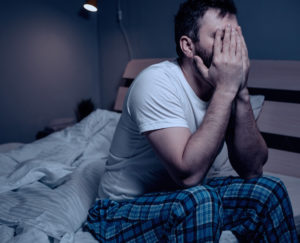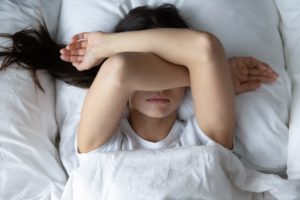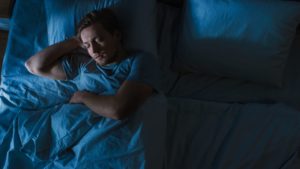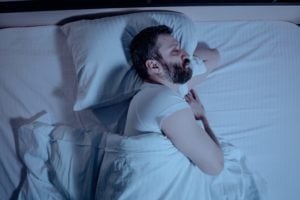Maladaptive Daydreaming: Symptoms, Diagnosis, and Tips
- Maladaptive daydreaming is a condition where one disassociates from reality and may act out what is happening in their daydreams.
- People may engage in maladaptive daydreaming as a response to depression, anxiety, or trauma.
- Treatment includes improving sleep hygiene and receiving therapy for related mental health issues.
It’s common to get lost in your thoughts every once in a while. Experts estimate we spend about 47% of our waking hours in a daydream, momentarily distracted from the world around us as we let our mind wander. If your daydreams are so intense that they interfere with your daily life, however, you may be a maladaptive daydreamer.
What Is Maladaptive Daydreaming?
Sometimes known as daydreaming disorder , maladaptive daydreaming describes a condition where a person regularly experiences daydreams that are intense and highly distracting — so distracting, in fact, that the person may stop engaging with the task or people in front of them. These daydreams may be triggered by real-life events or stimuli, such as a noise, smell, conversation topic, or movie.
Is Your Troubled Sleep a Health Risk?
A variety of issues can cause problems sleeping. Answer three questions to understand if it’s a concern you should worry about.
Maladaptive dreamers may dissociate from reality to absorb themselves completely in their daydream and may unknowingly act out the behavior or speak the dialogue of characters in their daydream. The content of daydreams can be richly detailed and fantastical, while others feature an idealized version of the daydreamer. Maladaptive daydreaming may develop as a coping strategy in response to trauma, as the inner world may feel safer than the experience happening outside. For example, people found themselves maladaptive daydreaming more frequently during the COVID-19 lockdown, when they felt a greater urge to daydream and the vividness of their daydreams intensified.
Maladaptive daydreaming was first defined in 2002 and is not yet recognized in the Diagnostic and Statistical Manual of Mental Disorders (DSM-5). The prevalence of maladaptive daydreaming is unknown , but the condition appears to be more common among people with anxiety, depression, or obsessive-compulsive disorder. Over half of maladaptive daydreamers have a mental health disorder.
Symptoms of Maladaptive Daydreaming
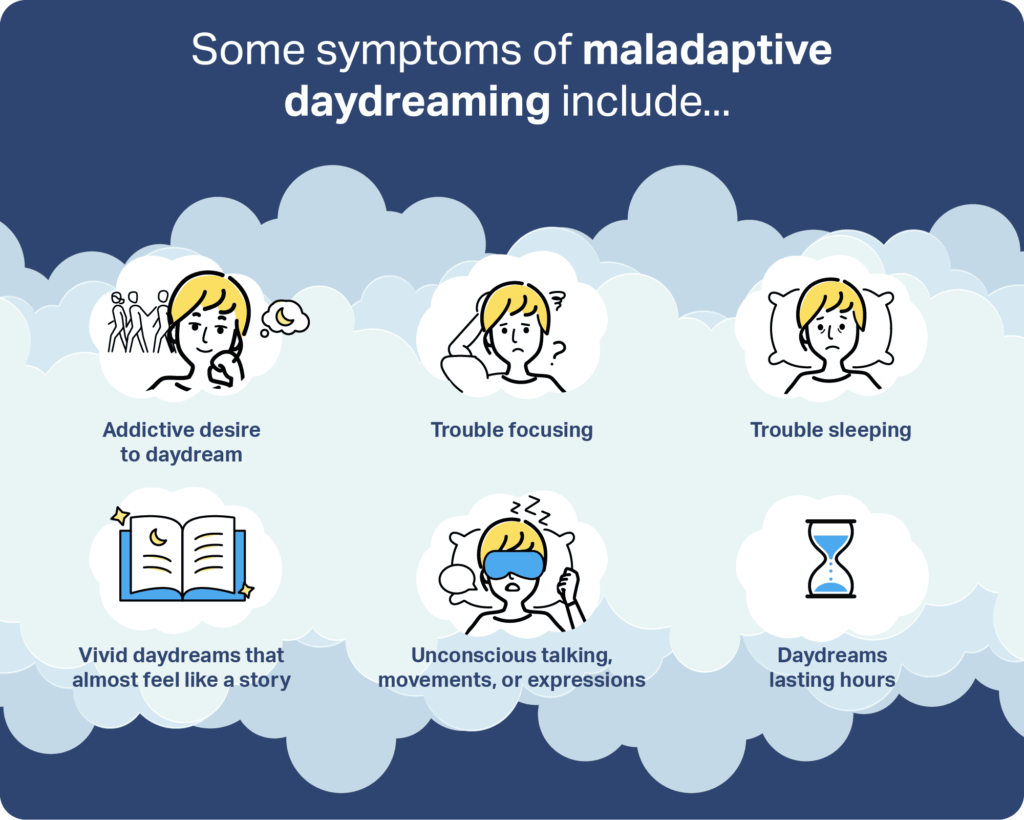
A person can exhibit one or more symptoms of maladaptive daydreaming, including:
- Intense, vivid daydreams that present as a story, with characters, settings, and plotlines
- Daydreams that are triggered by real-world events or sensory stimuli
- Unconscious facial expressions, repetitive body movements, or talking or whispering that accompany daydreams
- Daydreams that last for several minutes to hours
- A strong or addictive desire to keep daydreaming
- Trouble focusing and completing daily tasks due to daydreams
- Trouble sleeping
Complications of Maladaptive Daydreaming
Maladaptive daydreams can be so immersive and lengthy that the person dissociates from the world around them, negatively impacting their relationships, work or school performance, sleep, and daily life. Studies of medical students have found that those who engaged in maladaptive daydreaming reported a significant decline in their GPA.
Maladaptive daydreamers may spend 4.5 hours of their day distracted by their daydreams. They may become so absorbed with their inner world that it becomes harder to ground themselves in reality. Due to the all-consuming, immersive nature of their daydreams, people may end up neglecting their relationships and responsibilities in the real world, causing them emotional distress. Unfortunately, despite the strong desire to daydream, people generally feel worse emotionally after doing so.
In general, people who daydream are more likely to have troubled sleep. Poor sleep can cause sleep deprivation, which impairs one’s ability to focus, concentrate, and pay attention — all symptoms of maladaptive daydreaming. This may explain why a night of disturbed sleep tends to be followed by a day of maladaptive daydreaming. In addition, some of the mental health conditions linked to maladaptive daydreaming, such as anxiety and depression, are associated with poor sleep.
What’s the Difference Between Daydreaming and Maladaptive Daydreaming?
Daydreams are a normal part of existence. They’re typically pleasant, though they can sometimes be annoying. While they can distract us from the task at hand, they offer several benefits, such as the ability to plan future events, relieve ourselves from boredom, find meaning in our life’s story, and boost our creativity .
While maladaptive daydreams can be pleasant as well, they are more likely to involve themes of violence, power, control, sex, captivity, or rescue and escape scenarios. Unlike traditional daydreams, maladaptive daydreams commonly enter the realm of fantasy.
Finally, normal daydreaming occurs entirely in the mind, while maladaptive daydreaming is an immersive experience that is often accompanied by repetitive movements, facial expressions, or verbalizations.

Maladaptive Daydreaming Diagnosis
Experts still do not know what causes maladaptive daydreaming, and there’s no official method of diagnosis. While it has been linked to social anxiety or previous trauma, people may develop maladaptive daydreaming without any prior trauma. There is also some evidence that maladaptive daydreamers tended to have active imaginations as children.
Early researchers developed a test known as the Maladaptive Daydreaming Scale (MDS) to further study and define the characteristics of MD. This 14-part self-assessment can help doctors determine whether a person is suffering from maladaptive daydreaming. A person rates the severity and frequency of their symptoms, answering questions like:
- What takes place in your daydreams? How vivid and detailed are they?
- Can you stop yourself from daydreaming? Do you want to?
- Do your daydreams interfere with your daily life?
Due to the nature of the symptoms, maladaptive daydreaming can be confused with schizophrenia; however, these conditions are very different. Most notably, individuals who experience maladaptive daydreaming know that their daydreams are not real, while those with disorders like schizophrenia have difficulty distinguishing reality from fantasy .
There is some overlap between maladaptive daydreaming and other conditions, however. Individuals with maladaptive daydreaming exhibit more symptoms of depression, general anxiety, social anxiety, and dissociation. They are also more likely to have attention deficit hyperactivity disorder (ADHD), obsessive-compulsive disorder (OCD) , and depression.
Treatment for Maladaptive Daydreaming
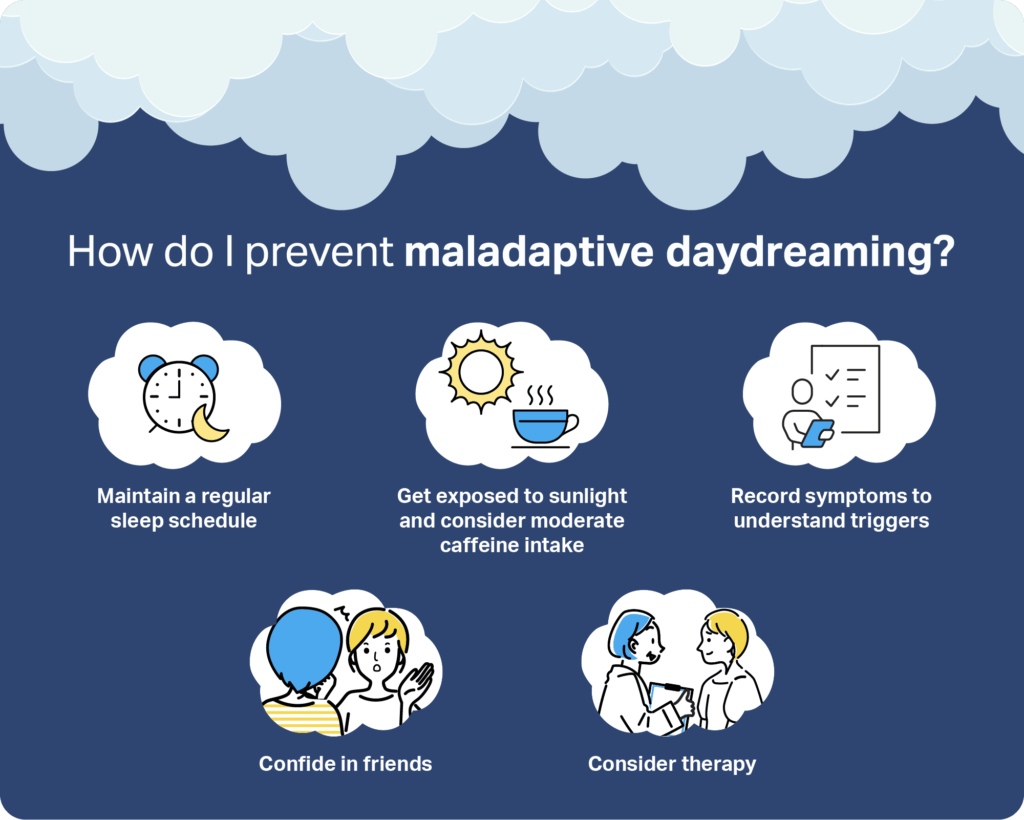
There is no official course of treatment for maladaptive daydreaming. Fluvoxamine, a drug commonly prescribed to treat OCD, was found effective in a case study of one patient. Typically, treatment focuses on reducing the likelihood of experiencing a maladaptive daydream through better sleep and symptom management.
Improve the Quality of Your Sleep
Adopting better sleep habits can improve your sleep quality and potentially have an impact on maladaptive daydreaming.
Set and follow a regular sleep schedule every day of the week, even weekends
- Provide yourself with enough time to enjoy at least seven hours of sleep
- Establish a calming bedtime routine to help you relax into sleep
- Exercise daily and eat well
Reduce Fatigue During the Day
Expose yourself to natural sunlight throughout the day, especially in the morning. Consider consuming caffeine for an extra boost, but avoid having more than 400 milligrams per day and schedule your last cup of coffee at least 6 hours before bed.
Understand Your Symptoms
Use a small notepad or the notes app on your phone to record what you were doing before you had a maladaptive daydream. Once you know what your triggers are, you can take steps to avoid them or understand why they’re triggering you.
Get Support
Explain your symptoms to people you trust, like family members and friends. This will help prevent your daydreams from straining the relationship while also enabling these people to help you by interrupting you when they notice symptoms occurring.
Consider Therapy
A therapist can help you process any underlying trauma and perhaps identify what’s triggering your maladaptive daydreaming. They can also recommend specific strategies for managing your symptoms. For example, grounding techniques can be helpful. Some therapists may also recommend changing your daydream’s plot endings from good to bad to make the daydream less rewarding.
If you feel addicted to daydreaming, or like your daydreams interfere with your daily life, talk to your doctor. They can provide recommendations for controlling your tendency to daydream and provide tips for better focus and better sleep.

Still have questions? Ask our community!
Join our Sleep Care Community — a trusted hub of sleep health professionals, product specialists, and people just like you. Whether you need expert sleep advice for your insomnia or you’re searching for the perfect mattress, we’ve got you covered. Get personalized guidance from the experts who know sleep best.
References
13 Sources
-
Killingsworth, M. A., & Gilbert, D. T. (2010). A wandering mind is an unhappy mind. Science (New York, N.Y.), 330(6006), 932.
https://pubmed.ncbi.nlm.nih.gov/21071660/ -
Soffer-Dudek, N., & Somer, E. (2018). Trapped in a daydream: daily elevations in maladaptive daydreaming are associated with daily psychopathological symptoms. Frontiers in Psychiatry, 9, 194.
https://pubmed.ncbi.nlm.nih.gov/29867613/ -
Somer, E. (2002). Maladaptive daydreaming: A qualitative inquiry. Journal of Contemporary Psychotherapy: On the Cutting Edge of Modern Developments in Psychotherapy, 32(2-3), 197–212.
https://psycnet.apa.org/record/2002-11146-005 -
Pietkiewicz, I. J., Nęcki, S., Bańbura, A., & Tomalski, R. (2018). Maladaptive daydreaming as a new form of behavioral addiction. Journal of Behavioral Addictions, 7(3), 838–843.
https://pubmed.ncbi.nlm.nih.gov/30238787/ -
Somer, E., Abu-Rayya, H. M., Schimmenti, A., Metin, B., Brenner, R., Ferrante, E., Göçmen, B., & Marino, A. (2020). Heightened levels of maladaptive daydreaming are associated with COVID-19 lockdown, pre-existing psychiatric diagnoses, and intensified psychological dysfunctions: a multi-country study. Frontiers in Psychiatry, 11, 587455.
https://pubmed.ncbi.nlm.nih.gov/33240135/ -
American Psychiatric Association. (2013). Diagnostic and statistical manual of mental disorders (5th ed.).
https://psychiatryonline.org/doi/book/10.1176/appi.books.9780890425596 -
Alenizi, M. M., Alenazi, S. D., Almushir, S., Alosaimi, A., Alqarni, A., Anjum, I., & Omair, A. (2020). Impact of maladaptive daydreaming on grade point average (GPA) and the association between maladaptive daydreaming and generalized anxiety disorder (GAD). Cureus, 12(10), e10776.
https://pubmed.ncbi.nlm.nih.gov/33033669/ -
Marcusson-Clavertz, D., West, M., Kjell, O., & Somer, E. (2019). A daily diary study on maladaptive daydreaming, mind wandering, and sleep disturbances: Examining within-person and between-persons relations. PloS One, 14(11), e0225529.
https://pubmed.ncbi.nlm.nih.gov/31774836/ -
Smallwood, J., & Schooler, J. W. (2015). The science of mind wandering: empirically navigating the stream of consciousness. Annual Review of Psychology, 66, 487–518.
https://pubmed.ncbi.nlm.nih.gov/25293689/ -
Somer, E., Lehrfeld, J., Bigelsen, J., & Jopp, D. S. (2016). Development and validation of the Maladaptive Daydreaming Scale (MDS). Consciousness and Cognition, 39, 77–91.
https://pubmed.ncbi.nlm.nih.gov/26707384/ -
National Institute of Mental Health. (2020, May). Schizophrenia. NIMH.
https://www.nimh.nih.gov/health/topics/schizophrenia/index.shtml -
Salomon-Small, G., Somer, E., Harel-Schwarzmann, M., & Soffer-Dudek, N. (2021). Maladaptive daydreaming and obsessive-compulsive symptoms: A confirmatory and exploratory investigation of shared mechanisms. Journal of Psychiatric Research, 136, 343–350.
https://pubmed.ncbi.nlm.nih.gov/33636690/ -
Schupak, C., & Rosenthal, J. (2009). Excessive daydreaming: a case history and discussion of mind wandering and high fantasy proneness. Consciousness and Cognition, 18(1), 290–292.
https://pubmed.ncbi.nlm.nih.gov/19062309/








